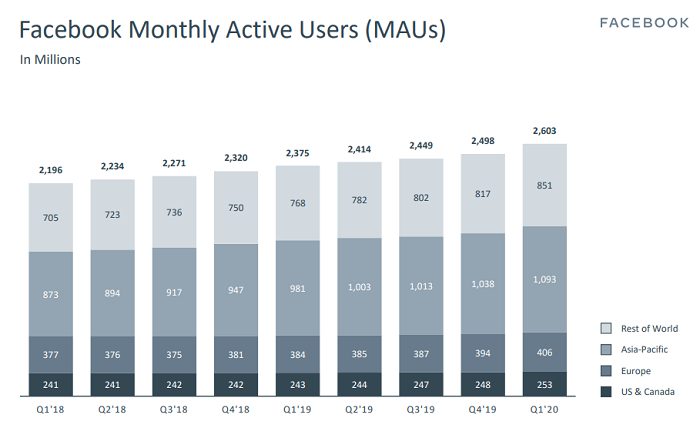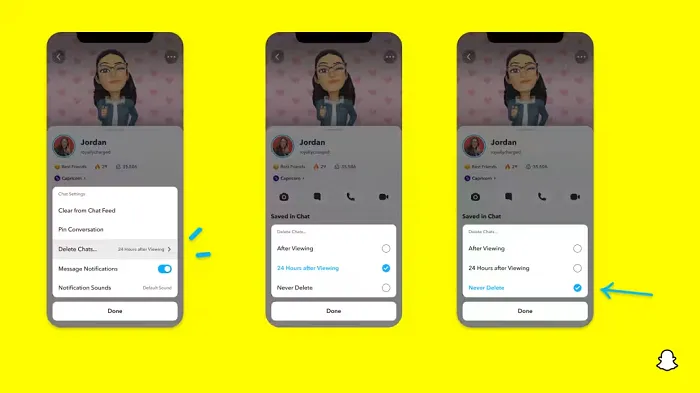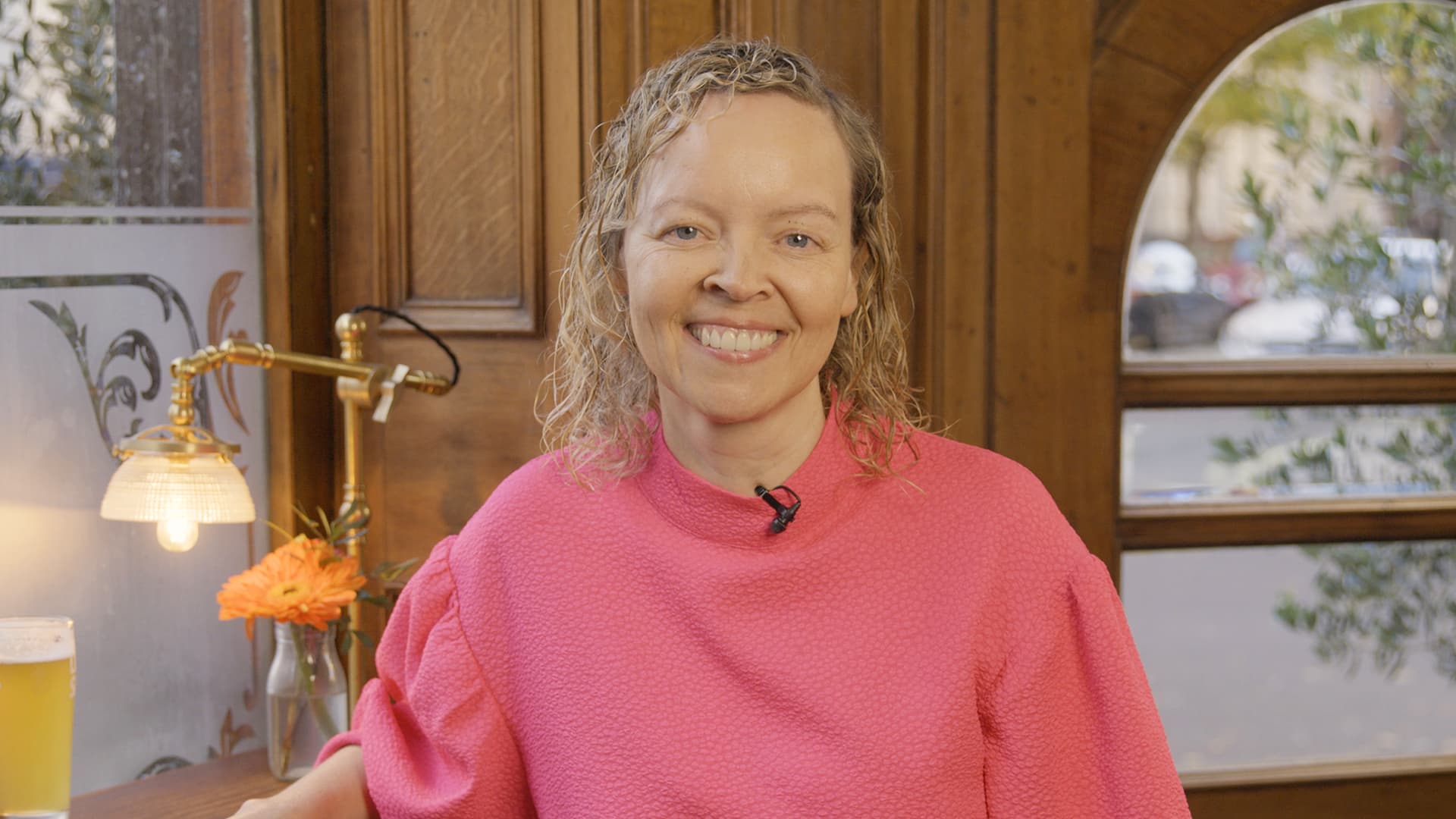SOCIAL
Facebook Closes in on New Milestone of 3 Billion Total Users Across its Platforms

Amid the uncertain impacts of COVID-19, Facebook has published its latest earnings report, showing double-digit increases users and revenue – though it has warned of a more significant slowdown on the horizon.
First off, on users – Facebook added 105 million users in Q1, taking it to 2.60 billion MAU, a 10% increase YoY.

Daily actives jumped 77 million in the quarter, the biggest increase since 2011, which come largely as a result of increased usage amid the COVID-19 lockdowns.

And while those results are impressive, Facebook has sought to temper expectation around such moving forward:
“Our community metrics, including Facebook DAUs and MAUs and Family MAP and DAP, reflect increased engagement as people around the world sheltered in place and used our products to connect with the people and organizations they care about. We expect that we will lose at least some of this increased engagement when various shelter-in-place restrictions are relaxed in the future.”
As with all businesses, it’s difficult to compare activity in the current period to normal times, as we are currently not living in a normal situation. But the numbers do show that Facebook remains a key resource for many users, and has once again been a key connective platform amid the pandemic.
In terms of region-specific trends, the Asia-Pacific market remains the biggest driver of growth for Facebook, with India, in particular seeing significant take-up as the developing nation undergoes its own digital shift. Facebook recently made a key step towards maximizing its opportunities in the region by purchasing a stake in Indian mobile provider Jio – which is noted in its accompanying statements around capex.
Across all of its apps – Facebook, Messenger, WhatsApp and Instagram – Facebook has also shared that it’s now close to reaching its next major milestone – 3 billion total users.

The true scope of that is hard to fathom – the population of the entire world is 7.8 billion, and when you also take into account that Facebook is banned in China (1.4b) and several other nations, and that only around half of the world is able to access the internet at all, Facebook’s active reach, via its various apps, is almost absolute in practical terms.
The vast majority of people who can access Facebook’s apps, use them, simple as that.
And while Zuck and Co have dealt with various PR disasters, privacy missteps, and other concerns that have lead some commentators to talk down the Facebook empire, the data is clear. Facebook’s reach is virtually unmatched, and its data resources are huge – and continue to grow every day.
In terms of revenue, Facebook brought in $17.74 billion in Q1, which beat analyst estimates.

But the company has warned of slowing ad growth as a result of COVID-19:
“We experienced a significant reduction in the demand for advertising, as well as a related decline in the pricing of our ads, over the last three weeks of the first quarter of 2020.”
Various reports have already pointed to a slowdown in Facebook’s ad business, which is largely reliant on advertiser volume, getting a lot of businesses to use its ad tools, as opposed to building on the back of fewer large providers. With many SMBs shut down due to the coronavirus mitigation effort, a downturn is expected, and Facebook is getting in early, flagging potential impacts in future reports.
“Due to the increasing uncertainty in our business outlook, we are not providing specific revenue guidance for the second quarter or full-year 2020, but rather a snapshot on revenue performance in the second quarter thus far.”
Facebook does note that it’s seen renewed signs of stability in its ad business over the first three weeks of April, but that would mean that it’s looking to post a flat result, as opposed to growth. That’s probably all that can be expected right now, but Facebook’s looking to manage market expectations now, ahead of those impacts.
Also, here’s an interesting new chart that Facebook has provided:

The company has reported average revenue per person across its entire family of apps, reflecting a slight year-on-year increase. Facebook will hard-pressed to boost that figure in the coming months, but it could be an interesting data point to note in future. It’s ARPP across its family of apps is also slightly lower than the average on Facebook alone ($6.95), which likely reflects that Instagram ARPP still has a way to go.
As noted, Facebook has also seen some significant outgoings of late, which will impact its overall position in Q2.
“Following the end of the quarter, we entered into an agreement to invest in Jio Platforms Limited, a subsidiary of Reliance Industries Limited, for approximately $5.7 billion, and we paid the $5.0 billion settlement amount due under our modified consent order with the FTC, which took effect in April 2020.”
Facebook finally received Federal Court approval of its agreement with the FTC over the Cambridge Analytica scandal last week, which will see it pay a $5 billion fine. The combined impact of this and its investment in Jio will reduce its margins in Q2, and with the expected reduction in advertiser spend, things may not look as good when Facebook next fronts analysts.
Still, these are expected, and Facebook has flagged such well in advance. Neither is likely to have a long term negative impact on the company’s standing (in fact, the opposite in the case of Jio).
Facebook also notes that it’s increased its headcount by 28% year-over-year to 49, 268, largely driven by increases in security and moderation – but at the same time, it’s expecting to see a reduction in operational expense in the immediate future due to reductions in travel, events, and marketing. Facebook is, however, looking to continue to invest in product development and recruiting technical talent moving forward. In addition to this, Facebook has also committed more than $300 million to COVID-19 relief efforts.
Overall, it’s another good report from Facebook, and the market has responded in kind, with signs pointing to ongoing growth, despite the expected downturn. The fact that Facebook says its ad businesses is already stabilizing is another key point of confidence, and as it also looks to ramp up its efforts in India, its dominance looks only set to increase.
SOCIAL
Snapchat Explores New Messaging Retention Feature: A Game-Changer or Risky Move?

In a recent announcement, Snapchat revealed a groundbreaking update that challenges its traditional design ethos. The platform is experimenting with an option that allows users to defy the 24-hour auto-delete rule, a feature synonymous with Snapchat’s ephemeral messaging model.
The proposed change aims to introduce a “Never delete” option in messaging retention settings, aligning Snapchat more closely with conventional messaging apps. While this move may blur Snapchat’s distinctive selling point, Snap appears convinced of its necessity.
According to Snap, the decision stems from user feedback and a commitment to innovation based on user needs. The company aims to provide greater flexibility and control over conversations, catering to the preferences of its community.
Currently undergoing trials in select markets, the new feature empowers users to adjust retention settings on a conversation-by-conversation basis. Flexibility remains paramount, with participants able to modify settings within chats and receive in-chat notifications to ensure transparency.
Snapchat underscores that the default auto-delete feature will persist, reinforcing its design philosophy centered on ephemerality. However, with the app gaining traction as a primary messaging platform, the option offers users a means to preserve longer chat histories.
The update marks a pivotal moment for Snapchat, renowned for its disappearing message premise, especially popular among younger demographics. Retaining this focus has been pivotal to Snapchat’s identity, but the shift suggests a broader strategy aimed at diversifying its user base.
This strategy may appeal particularly to older demographics, potentially extending Snapchat’s relevance as users age. By emulating features of conventional messaging platforms, Snapchat seeks to enhance its appeal and broaden its reach.
Yet, the introduction of message retention poses questions about Snapchat’s uniqueness. While addressing user demands, the risk of diluting Snapchat’s distinctiveness looms large.
As Snapchat ventures into uncharted territory, the outcome of this experiment remains uncertain. Will message retention propel Snapchat to new heights, or will it compromise the platform’s uniqueness?
Only time will tell.
SOCIAL
Catering to specific audience boosts your business, says accountant turned coach

While it is tempting to try to appeal to a broad audience, the founder of alcohol-free coaching service Just the Tonic, Sandra Parker, believes the best thing you can do for your business is focus on your niche. Here’s how she did just that.
When running a business, reaching out to as many clients as possible can be tempting. But it also risks making your marketing “too generic,” warns Sandra Parker, the founder of Just The Tonic Coaching.
“From the very start of my business, I knew exactly who I could help and who I couldn’t,” Parker told My Biggest Lessons.
Parker struggled with alcohol dependence as a young professional. Today, her business targets high-achieving individuals who face challenges similar to those she had early in her career.
“I understand their frustrations, I understand their fears, and I understand their coping mechanisms and the stories they’re telling themselves,” Parker said. “Because of that, I’m able to market very effectively, to speak in a language that they understand, and am able to reach them.”Â
“I believe that it’s really important that you know exactly who your customer or your client is, and you target them, and you resist the temptation to make your marketing too generic to try and reach everyone,” she explained.
“If you speak specifically to your target clients, you will reach them, and I believe that’s the way that you’re going to be more successful.
Watch the video for more of Sandra Parker’s biggest lessons.
SOCIAL
Instagram Tests Live-Stream Games to Enhance Engagement

Instagram’s testing out some new options to help spice up your live-streams in the app, with some live broadcasters now able to select a game that they can play with viewers in-stream.
As you can see in these example screens, posted by Ahmed Ghanem, some creators now have the option to play either “This or That”, a question and answer prompt that you can share with your viewers, or “Trivia”, to generate more engagement within your IG live-streams.
That could be a simple way to spark more conversation and interaction, which could then lead into further engagement opportunities from your live audience.
Meta’s been exploring more ways to make live-streaming a bigger consideration for IG creators, with a view to live-streams potentially catching on with more users.
That includes the gradual expansion of its “Stars” live-stream donation program, giving more creators in more regions a means to accept donations from live-stream viewers, while back in December, Instagram also added some new options to make it easier to go live using third-party tools via desktop PCs.
Live streaming has been a major shift in China, where shopping live-streams, in particular, have led to massive opportunities for streaming platforms. They haven’t caught on in the same way in Western regions, but as TikTok and YouTube look to push live-stream adoption, there is still a chance that they will become a much bigger element in future.
Which is why IG is also trying to stay in touch, and add more ways for its creators to engage via streams. Live-stream games is another element within this, which could make this a better community-building, and potentially sales-driving option.
We’ve asked Instagram for more information on this test, and we’ll update this post if/when we hear back.
-
SEARCHENGINES6 days ago
Daily Search Forum Recap: April 19, 2024
-

 WORDPRESS7 days ago
WORDPRESS7 days agoHow to Make $5000 of Passive Income Every Month in WordPress
-

 WORDPRESS6 days ago
WORDPRESS6 days ago13 Best HubSpot Alternatives for 2024 (Free + Paid)
-

 MARKETING6 days ago
MARKETING6 days agoBattling for Attention in the 2024 Election Year Media Frenzy
-

 WORDPRESS6 days ago
WORDPRESS6 days ago7 Best WooCommerce Points and Rewards Plugins (Free & Paid)
-

 AFFILIATE MARKETING7 days ago
AFFILIATE MARKETING7 days agoAI Will Transform the Workplace. Here’s How HR Can Prepare for It.
-

 MARKETING5 days ago
MARKETING5 days agoAdvertising in local markets: A playbook for success
-

 SEO6 days ago
SEO6 days agoGoogle Answers Whether Having Two Sites Affects Rankings



